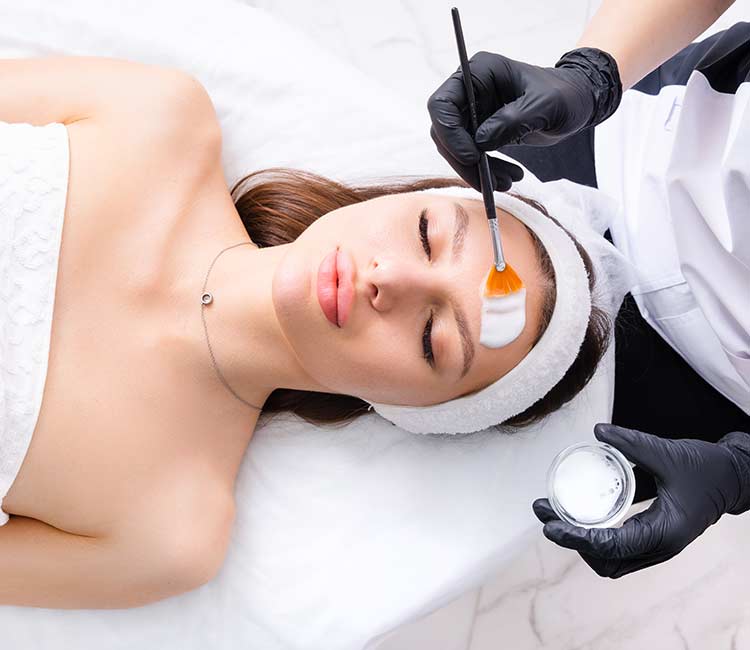The combined peel is an aesthetic medicine procedure that involves using several types of chemical peels during the same session to treat different layers of the skin. The combined peel allows action at multiple levels depending on the patient's specific skin needs.
This versatile approach offers a customized treatment, as it makes it possible to simultaneously address various skin imperfections.
This type of peel is often used to deeply exfoliate, stimulate cell renewal, even out the complexion, and improve the overall texture of the skin.
It is ideal for people wishing to treat a variety of skin concerns, such as :
• Pigmentation spots (dark spots, sunspots).
• Fine lines and wrinkles.
• Enlarged pores.
• Dull complexion.
• Sagging skin.
Le peeling combiné est une technique innovante en médecine esthétique, idéale pour les patients qui souhaitent rajeunir leur peau, atténuer les imperfections et retrouver un teint lumineux. Il s’agit d’un traitement qui associe plusieurs types de peelings ce qui rend possible une action sur les différentes couches de la peau pour des résultats optimaux
The combined peel is particularly appreciated for its ability to simultaneously treat several skin concerns, such as pigmentation spots, fine lines, acne and skin laxity, while stimulating cell renewal.

The principle of the combined peel is to use several specific exfoliating agents that act on different layers of the skin for maximum effectiveness. Each chemical agent used in peels has its own characteristics, such as depth of action, penetration speed, and effects on the skin. By combining several acids, it is possible to target multiple skin issues at once.
The combined peel offers numerous advantages over traditional peels thanks to its ability to treat multiple layers of the skin and target several skin concerns in a single session.
• More visible and longer-lasting results : by combining several types of acids, the combined peel acts at different depths of the skin, ensuring more noticeable and lasting results. It promotes thorough exfoliation and stimulates cell renewal both on the surface and in the deeper layers.
• Personalized treatment : the treatment can be tailored to the specific needs of each patient. Whether you want to treat pigmentation spots, acne scars, fine lines, or dull skin, the combined peel can be adjusted to precisely meet your expectations.
• Overall improvement in skin quality : this type of peel works on multiple levels – it improves skin texture, smooths fine lines, reduces pigmentation spots, and gives a radiant complexion. By stimulating collagen production, it also helps to firm the skin, making it appear younger and more luminous.
• Reduction of imperfections : combined peels are particularly effective for addressing skin issues such as acne, scars, and enlarged pores. They unclog pores, reduce excess sebum, and help prevent future breakouts.

The combined peel is suitable for all skin types, but it is especially recommended for individuals with multiple skin concerns or those looking for a comprehensive solution to rejuvenate their face. It is important to consult an experienced physician to receive a personalized peel and to ensure that the treatment is appropriate for your skin type and specific needs before undergoing a combined peel.
This treatment is ideal for :
• Individuals with mature skin looking to reduce signs of aging.
• Patients with acne.
• Individuals with uneven skin tone or pigmentation spots.
The combined peel is recommended to address several skin issues :
•
Pigmentation spots : spots, sun spots, or brown spots.
• Acne scars : the combined peel helps smooth the skin and reduce the appearance of acne scars.
• Fine lines and wrinkles : medium peels stimulate collagen production, reducing superficial wrinkles.
• Dull complexion : by exfoliating dead skin cells, the combined peel restores a natural, radiant glow.
• Skin laxity : the acids used in combined peels stimulate tissue regeneration, improving skin firmness.
Several exfoliating agents may be combined in a combined peel, each with specific properties and different actions on the skin.
Salicylic acid is a beta hydroxy acid (BHA) that penetrates deeper into the skin, particularly into the pores. It is ideal for oily and acne-prone skin due to its anti-inflammatory and exfoliating properties. This acid helps :
• Dissolve excess sebum.
• Clear clogged pores.
• Reduce blemishes and breakouts.
Glycolic acid is an alpha hydroxy acid (AHA) derived from sugarcane. It is commonly used in superficial peels to exfoliate the uppermost layer of the skin, thereby accelerating cell renewal. Glycolic acid is particularly effective for:
• Removing dead skin cells.
• Stimulating collagen production.
• Smoothing and brightening the skin.
L’acide trichloroacétique (TCA) est souvent utilisé dans les peelings moyens à profonds. Il agit en profondeur dans la peau pour traiter les cicatrices d’acné, les taches brunes et les rides. Il stimule la production de collagène, ce qui permet de raffermir la peau et de réduire les signes visibles de vieillissement.
The Jessner peel is a blend of acids (salicylic acid, lactic acid, and resorcinol) used for deep exfoliation and to treat skin imperfections such as acne, pigmentation spots, and fine lines. It is often combined with other peels for more targeted action.
L’acide mandélique est un AHA doux, particulièrement adapté aux peaux sensibles ou sujettes à l’hyperpigmentation, comme les peaux noires et mates. Il aide à améliorer le teint, à réduire les taches pigmentaires et à lisser la texture de la peau. Cet acide irrite très peau la peau.

Before applying the exfoliating agents, the skin is carefully cleansed to remove impurities and allow better product penetration.
Application of a superficial peel : a light peel is first applied to exfoliate the upper layer of the epidermis, eliminate dead skin cells, and stimulate cell renewal.
Application of personalized peels : different peels are applied according to the imperfections being targeted.
Neutralization and post-peel care : once the chemical agents have taken effect, the peel is neutralized and a healing cream is applied to promote recovery.
After a combined peel, it is essential to follow certain recommendations to speed up healing and prevent complications.
• Sun protection : the skin is more sensitive to UV rays after a peel. It is therefore crucial to use SPF 50 sunscreen daily and avoid direct sun exposure.
• Hydration : use suitable moisturizers to soothe the skin and prevent dehydration.
• Avoid irritating the skin : avoid products containing strong acids (such as retinol or AHAs) for several days after the peel.
• Specific instructions : doctor Romano will explain the precautions to follow based on the type of peel performed.
The results of a combined peel are visible shortly after the treatment. In general, patients notice smoother, more radiant skin and an even complexion in the days following the procedure. Depending on the depth of the peel, multiple sessions may be required to achieve optimal results.
After the treatment, the skin continues to improve over the following weeks due to the stimulation of cell renewal and collagen production.
The combined peel is offered from 300 CHF per session at Dr. Romano’s clinic in Geneva. This base price corresponds to a simple peel, but it may vary depending on the complexity of the recommended treatment.
The final cost depends on several factors : the number of peels combined in a single session, the nature of the active ingredients used, and the total number of sessions required to achieve the desired results. This type of treatment is particularly indicated for addressing complex skin issues such as pigmentation spots, texture irregularities, or persistent imperfections.
A personalized assessment is always carried out during the initial consultation to define a customized treatment strategy. The price is then clearly and transparently communicated, based on the patient’s specific needs.
All treatments are carried out in a strict medical setting, in accordance with Swiss standards of quality and safety.
Le peeling combiné associe plusieurs types d’acides pour cibler différentes problématiques cutanées en une seule séance. Il offre des résultats plus complets, permettant de traiter simultanément les taches, les rides, l’acné et le teint terne. Cette approche optimise l’efficacité du traitement tout en réduisant le temps de récupération.
Peels can be combined based on the nature of the acids and the skin’s needs. For example :
• Glycolic acid + salicylic acid : ideal for oily and acne-prone skin.
• Lactic acid + mandelic acid : perfect for sensitive or dull skin.
• Trichloroacetic acid (TCA) + kojic acid : effective for pigmentation spots and skin laxity.
The combination is always personalized and requires a professional evaluation.
Oui, le peeling combiné peut être adapté à tous les types de peau, mais il nécessite une évaluation préalable. Les peaux sensibles ou foncées doivent faire l’objet d’une attention particulière pour éviter les risques d’irritation ou d’hyperpigmentation.
Un peeling combiné peut être réalisé tous les 2 à 3 mois, en fonction de la sensibilité de la peau et de l’intensité du traitement. Des séances d’entretien peuvent être espacées davantage, selon les résultats obtenus et les recommandations du médecin.